San Onofre and America’s spent fuel pools are easy terrorist targets
An EnviroReporter.com Special Investigation

The San Onofre Nuclear Generating Station, or SONGS, sits south of San Clemente along the Southern California coast between Los Angeles and San Diego. A four-month investigation reveals that the shuttered plant’s spent nuclear fuel rods are vulnerable to earthquakes and terrorist attacks which could result in a “black swan” event – a foreseeable but ignored disaster of epic proportions. Spent fuel pools’ vulnerability nationwide is well known to nuclear watchdogs like the ones that succeeded in shutting down SONGS. The phlegmatic government and nuclear power industry responses to these threats are inadequate to the challenge. EnviroReporter.com exposes the vulnerabilities and proposes solutions that should be enacted.
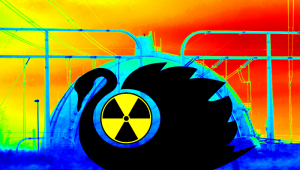 INTRODUCTION
INTRODUCTION
This introduction to our four-part Black Swan SONGS series reveals that even though SONGS’ was permanently shuttered in June 2013, its security posture is questionable at best and possibly not robust enough to withstand a concerted terrorist attack. The methods, men and material needed for such an strike are already in place as are the targets. Ready solutions do exist.
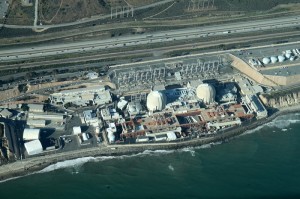 PART ONE – SONGS’ LETHAL LEGACY
PART ONE – SONGS’ LETHAL LEGACY
Should one of SONGs’ spent fuel pools be cracked by an earthquake or lose power to circulate the cooling pools, the water would drain or evaporate away and the heat of the extremely radioactive rods could ignite a blaze that would be nearly impossible to extinguish. According to a 2007 Nuclear Regulatory Commission disaster scenario involving SONGS’ pools on fire, everyone within ten miles of San Onofre would get a fatal dose of radiation. Yet new dubious NRC studies discount any problems.
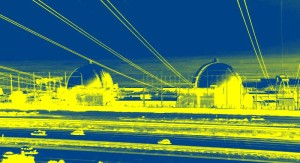 PART TWO – SONGS’ RISKY BUSINESS
PART TWO – SONGS’ RISKY BUSINESS
Newport-Inglewood Fault threatens San Onofre with quake 2.5 times as strong as plant’s maximum tolerance. Post 9/11 security measures Collins reported on in 2001 seem nonexistent now. SONGS spent fuel pools are vulnerable to rocket attack which can be prevented. If SPF catches fire, it would be an inextinguishable fire. Fallout radiation doses would be life-threatening up to 10 miles out.
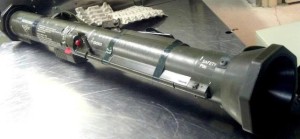 PART THREE – HIT MEN FOR HOT ZONES
PART THREE – HIT MEN FOR HOT ZONES
FBI establishes connection between Iranian terrorism and Mexican cartel gunslingers in sting. Syria and Iran threaten U.S. Cartels recruit U.S. gangs and soldiers for hit men. Threat to SONGS spent fuel pools and dry casked nuclear rods detailed along with weaponry, explosives and potential terrorists. Backpack C-4 bomb risk.
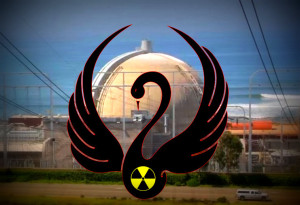 PART FOUR – STOPPING SONGS’ BLACK SWAN
PART FOUR – STOPPING SONGS’ BLACK SWAN
Series finale shows how to protect San Onofre and Peach Bottom nuclear reactor complex’s spent fuel pools and dry casks of highly-radioactive nuclear fuel rods from terrorism. Even with exposing the failings of the Nuclear Regulatory Commission helped by an error-plagued Department of Defense report, common sense can prevail. SONGS is within the perimeter of a Marine base and there lies its external security answers. Each other nuke complex in country has unique challenges to reduce black swan threat to as low as reasonably achievable.
INTRODUCTION
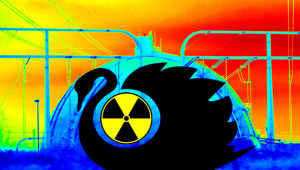 The giant concrete domes of the nuclear reactors hard on the Pacific look no different now that the plant is closing. They are ominous and foreboding but may seem less so because both of the two remaining reactors, Units 2 and 3, have been shut down for good.
The giant concrete domes of the nuclear reactors hard on the Pacific look no different now that the plant is closing. They are ominous and foreboding but may seem less so because both of the two remaining reactors, Units 2 and 3, have been shut down for good.
The San Onofre Nuclear Generating Station or SONGS, sits south of San Clemente along the Southern California coast. It is owned primarily by Southern California Edison [SCE] and San Diego Gas & Electric. It now faces an uncertain future as the company haggles with the government and public over the billions it still wants to squeeze out of its ratepayers to foot the bill for its multi-billion dollar boondoggle.
Southern California faces an even more uncertain future thanks to the amount of radioactive material at the site, so much highly toxic material that if unleashed could kill a huge chunk of the Southland making it uninhabitable for thousands of years. This makes it a pre-placed high-value terrorist target.
Even though SCE’s decision to permanently shutter the reactors removes the possibility of a reactor meltdown, the nuclear complex is a disaster waiting to happen. SONGS will never generate a watt of electricity again but its spent reactor fuel situation is in critical danger of catastrophe that would far exceed a reactor core meltdown.
This series reveals that SONGS’ security posture is questionable at best and possibly not robust enough to withstand a concerted terrorist attack. Nearly twelve years ago, this reporter exposed the plant’s vulnerability to terrorist attack in an LA Weekly article that came out two months after 9/11. Despite assurances then of robust security, none of it was evident to reporters on repeated visits to the site. SCE assured this reporter years ago of having weaponry that NRC documents obtained by EnviroReporter.com show weren’t even available to the agency at the time.
Two new Nuclear Regulatory Commission studies have risen alarm bells about what the NRC plans to do with the thousands of tons of highly radioactive spent fuel rods jammed into spent fuel pools (SFPs) around the country, including SONGS.
One of the NRC reports posits that it’s safe to leave spent fuel rods in pools at reactor sites for up to 60 to 100 years after the plant closes, in addition to the decades the rods would stay in the pools while the reactors were still operating. The study even goes so far as to discourage transferring the rods to safer dry casks saying that it doesn’t matter at all and the workers risk dropping one.
Another report analyzed in this series investigates the spent fuel pool of the Peach Bottom Power Plant reactor in Pennsylvania with the same design as the three reactors that melted down in Fukushima Japan. The NRC determined that a major SFP fire could only happen less than once is ten million years.
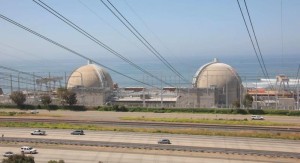 This EnviroReporter.com investigation shows that the SONGS complex astride the San Diego Freeway is one terrorist attack away from a mega-disaster that would dwarf the ongoing triple meltdowns at Fukushima. Despite several government reports analyzed in this series that maintain that the chance of nuclear accidents are infinitesimally low, this in-depth analysis of SONGS and the Peach Bottom nuclear power plant in Pennsylvania comes to a different conclusion.
This EnviroReporter.com investigation shows that the SONGS complex astride the San Diego Freeway is one terrorist attack away from a mega-disaster that would dwarf the ongoing triple meltdowns at Fukushima. Despite several government reports analyzed in this series that maintain that the chance of nuclear accidents are infinitesimally low, this in-depth analysis of SONGS and the Peach Bottom nuclear power plant in Pennsylvania comes to a different conclusion.
Both reactor complexes are vulnerable to terrorist attack that could involve light arms and explosives, which could destroy their spent fuel pools. SONGS seems to have implemented none of the heightened security measures it told this reporter that it had initiated a month after 9/11. Weapons and explosives available on American streets can inflict serious destruction on both reactor complexes with relative ease. The violent men needed to mount such an attack are already on the streets of America, and some come with Mexican cartel connections.
An August 15 University of Texas report funded by the Office of the Secretary of Defense adds new urgency to the issue. Though marred by factual inaccuracies and dubious generalizations, the research assistant-written “working study” acknowledges that every nuclear reactor complex in the country is under threat of terrorist attack and is coming up short securing against such a scenario. The consequences of even one successful attack could kill hundreds of thousands of Americans and cost trillions.
Despite its shortcomings, the U of T paper provides valuable information and a look into the mindset of the Defense Department regarding nuclear installation security as will be seen in this investigative series. It may seem a hopeful sign that the DOD paid for and publicized a report addressing a clear and present dangerous facing the 65 commercially operating nuclear power sites in 31 states with 104 nuclear reactors and over 200 spent fuel pools. It is not.
Not only was the DOD paper factually flawed, it came to the bewildering conclusion that there should be a generic approach to nuclear reactor and SFPs security instead of taking each plant on a case by case basis. That the supposedly most advanced and powerful military in the world would allow an amateurish paper stand as the best it can provide about such a potential terrorist target speaks volumes for how little regard DOD holds for the issue.
The Defense Department report is just the latest in a string of government studies that ignore the most obvious questions of all: how would terrorists, homegrown or foreign, attack each nuclear installation to literally get the most bang for the buck? And how would we make sure that such an attack cannot possibly succeed because the consequences are unacceptable on any level?
This four month investigation will show that the Nuclear Regulatory Commission, Department of Energy, the DOD and America’s sixteen intelligence agencies have fallen fall short in their duties to protect the American people from a preventable nuclear calamity. The failure to even recognize the dangers uncovered in the Black Swan SONGS series can be remedied by doing the obvious: go look in person and on the Internet.
Even with the advantage of reporting on this subject since 2001, anyone can find out what EnviroReporter.com has found and puzzled together. That includes terrorists, who could find SONGS a spectacular target, one that would not only permanently cripple Southern California, but also take out the largest Marine base on the West Coast, Camp Pendleton.
SCE’s lack of concerted efforts to defuel the vulnerable spent fuel pools and a lack of vision of how to securely store San Onofre’s spent fuel rod assemblies in dry casks reveals an approach that puts more faith in probability than physical protection and deterrence.
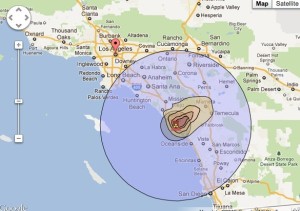 SONGS is a ‘black swan’ event waiting to happen. Black swan theory uses the metaphor to describe a major surprise event that is unexpected and usually disastrous. The philosophy is the brainchild of intellectual luminary Nassim Nicholas Taleb, whose 2007 bestselling book The Black Swan explores these infrequent and unpredictable events. Taleb posits that humans rationalize these events in retrospect when they should be trying to build robust defenses against unexpected catastrophes. Act now instead of making excuses later.
SONGS is a ‘black swan’ event waiting to happen. Black swan theory uses the metaphor to describe a major surprise event that is unexpected and usually disastrous. The philosophy is the brainchild of intellectual luminary Nassim Nicholas Taleb, whose 2007 bestselling book The Black Swan explores these infrequent and unpredictable events. Taleb posits that humans rationalize these events in retrospect when they should be trying to build robust defenses against unexpected catastrophes. Act now instead of making excuses later.
The ongoing and worsening triple meltdowns at Fukushima Dai-ichi provide a nightmarish world of lessons to be learned. But the NRC’s response has been to do next to nothing other than produce detailed reports explaining away any chance that something could go wrong with the mountain of spent nuclear fuel in the U.S.
As with SONGS and Peach Bottom, nuclear reactors were built in a time when the specter of terrorism was far less than today. The Obama Administration says that the threat of al-Qaeda is real. Syria and Iran have threatened this country with terrorist retaliation should it use military strikes in response Syria’s use of chemical weapons. “Homegrown” terrorists have also become a serious concern.
No country should ever start a war if a known tactical weakness, in this case over a hundred of them, could undo the nation. It would be strategic suicide. The weaknesses identified in this series come with answers that are real and not the result of some tortured data crunching that spits out whatever “science” it takes to bolster a phony ‘it will never happen’ study.
A black swan event at SONGS is an avoidable apocalypse. The security of the San Onofre complex on both sides of the freeway could be made substantially safer tomorrow by immediate security measures also identified in Black Swan SONGS.













EnviroReporter.com readers may remember our 2013 exposé “Black Swan SONGS” came out this week six years ago. As subsequently reported, the situation has gone from bad to worse but a new threat poses one of the gravest dangers to Southern California yet: destruction of the spent fuel pools at San Onofre Nuclear Generating Station (SONGS). This is a supremely bad idea as explained below by our friends at San Clemente Green who urge YOU to SIGN THIS PETITION called “Tell California Coastal Commission: DENY Permit to destroy Spent Fuel Pools” which is included following San Clemente Green’s urgent message:
SAN CLEMENTE GREEN MESSAGE:
October 8, 2019
We must demand that the Coastal Commission deny Edison a permit to destroy our only means of protection from a damaged or leaking nuclear waste canister at San Onofre and for transportation in the future.
Conditions exist that would require nuclear waste to be transferred back into the spent fuel pools from which they came, to be reloaded for transportation or if they are damaged or leaking before that time.
The Nuclear Waste Technical Review Board recently concluded that most nuclear waste containers in use today will need to be reloaded before transportation would be possible.
For these reasons alone, we must maintain the pools until all waste has been relocated or until a “hot cell” is built on site for the same purpose.
We encourage you to oppose the Edison application when the Coastal Commission meets at 9 a.m. Oct. 17 at the Chula Vista City Council chambers, 276 4th Ave., Chula Vista.
Please email commissioners before
5 p.m. Friday, Oct. 11:
Address: EORFC@coastal.ca.gov
Subject: Thursday, Oct. 17, Item 12A,
App. # 9-19-0194 (Southern California Edison)
Suggested message:
Dear Commissioners,
Please DENY Application No. 9-19-0194 for the onshore portion of decommissioning of Units 2 and 3 at San Onofre Nuclear Generating Station. In light of serious, documented defects with its dry storage system, Southern California Edison must not be granted a permit to destroy its spent fuel pool until its dry storage containers can meet requirements for the waste to eventually be transported away from the facility. Otherwise, a “Hot Cell” must be constructed on site for the same purpose. Stranding the nuclear waste on the coast would be a direct violation of the terms upon which the Coastal Commission approved the plans for the interim dry storage facility in 2015.
You can also sign our petition which will be presented to the Commissioners and other elected officials.
Documents recently provided through Freedom Of Information Act (FOIA) reveal the actual damage that is being ignored. In regards to the NRC granting Edison a green light to continue damaging canisters in the downloading operations, one of their own objected. Lee Brookhart, (NRC Region IV, Division of Nuclear Materials Safety, Fuel Cycle and Decommissioning Branch, Senior ISFSI Inspector) said. “… Essentially the change (in methodology) is adding an alternative to the code to not have to do inspections and repair these new defects.”
In other words, instead of actually fixing the problem they simply changed the rules to make gouged canisters acceptable.
TEXT OF PETITION:
Dear Commissioners,
Please DENY Application No. 9-19-0194 for the onshore portion of decommissioning of Units 2 and 3 at San Onofre Nuclear Generating Station. In light of serious, documented defects with its dry storage system, Southern California Edison must not be granted a permit to destroy its spent fuel pool until its dry storage containers meet requirements for the waste to someday be transported away from the facility. Otherwise, a “Hot Cell” must be constructed on site for the same purpose. Stranding the nuclear waste on the coast would be a direct violation of the terms upon which the Coastal Commission approved the plans for the interim dry storage facility in 2015.
Click on THIS LINK to see detailed references about this matter.
SPONSOR
San Clemente Green
USA
22st August 2018 – San Onofre SOS! Update on Accident Near-Miss w/Donna Gilmore + New Int’l Nuke News Source – Linda Pentz Gunter NH #374 (Radio Interview)
Extract:
San Onofre Safety‘s Donna Gilmore tells what she tried to say to Southern California Edison at the August 9 Community EnRagement, uh, Engagement Panel when the “experts” shouted her down. More scary information on how the nuclear industry is playing loose and fast with highly radioactive nuclear reactor waste, as well as Southern California’s future.
http://nuclearhotseat.com/2018/08/22/sos-san-onofre-accident-near-miss-update-w-donna-gilmore-new-intl-nuke-news-source-linda-pentz-gunter-nh-374/
Our friends at Physicians for Social Responsibility – Los Angeles sent us this important notice just now. It includes some of our most important recommendations and is one of your last chances to act.
Right now, 3.6 million pounds of highly radioactive nuclear waste at San Onofre Nuclear Generating Station (SONGS) near San Diego are in the process of being buried on the beach, just 100 feet from the ocean and a mere few feet above the water table. This puts the health and safety of the community and environment at alarming risk.
Demand a better solution: the nuclear waste should be moved off the beach to a new, above-ground concrete-reinforced temporary storage facility located further east in Camp Pendleton—where it can be protected from sea level rise and potential terrorist attack. Nuclear waste experts including former Nuclear Regulatory Commission Chief Greg Jaczko, U.S. government advisor on nuclear waste Tom English, and retired Navy Admiral Len Herring, among others, have publicly supported this alternative.
Take action by sending a comment on the draft Environmental Impact Report for SONGS’ decommissioning and tell the California State Lands Commission that moving spent fuel storage to the Mesa or another site further east in Camp Pendleton is the only safe and ethical choice until a scientifically sound national repository is available.
Comments are due August 28 so please take action today!
Sincerely,
All of us at PSR-LA
13th August 2018 – San Onofre Nuclear Waste Accident Near Miss
Extracts:
While working at the plant in his capacity as a safety professional, Fritch observed first hand a near catastrophe. On 3 August 2018, a 100-ton canister filled with highly radioactive nuclear waste was being “downloaded” into a temporary transport carrier to be moved a few hundred yards from inside the plant to a storage silo buried near the world-famous San Onofre beach. As the thin-walled canister was being lowered into the transport cask, it snagged on a guide ledge four feet from the top. Crane operators were unaware that the canister had stopped descending and the rigging went completely slack, leaving the full weight of the heavy canister perched on that ledge by about a quarter-inch.
Had the ledge not held for the hour or more it took workers to realize and address the error, the thin-walled canister of highly toxic nuclear waste would have fallen 18 feet to the ground below.
A Quarter Inch from Chernobyl
Comment:
I strongly suggest everyone watch the 5 minute video in this article.
https://danapointer.com/san-onofre-nuclear-waste-accident-near-miss/
EnviroReporter.com‘s prescient exposés over the years showing how vulnerable our aged and dangerous nuclear power plant should have been a wake-up call to toughen up standards and security. Now it may be too late with Russia having penetrated America’s critical and nuclear infrastructure according to today’s Ides of March U.S. U.S. Department of Homeland Security Computer Emergency Readiness Team (US-CERT) ALERT.
Original release date: March 15, 2018
Systems Affected
Domain Controllers
File Servers
Email Servers
Overview
This joint Technical Alert (TA) is the result of analytic efforts between the Department of Homeland Security (DHS) and the Federal Bureau of Investigation (FBI). This alert provides information on Russian government actions targeting U.S. Government entities as well as organizations in the energy, nuclear, commercial facilities, water, aviation, and critical manufacturing sectors. It also contains indicators of compromise (IOCs) and technical details on the tactics, techniques, and procedures (TTPs) used by Russian government cyber actors on compromised victim networks. DHS and FBI produced this alert to educate network defenders to enhance their ability to identify and reduce exposure to malicious activity.
DHS and FBI characterize this activity as a multi-stage intrusion campaign by Russian government cyber actors who targeted small commercial facilities’ networks where they staged malware, conducted spear phishing, and gained remote access into energy sector networks. After obtaining access, the Russian government cyber actors conducted network reconnaissance, moved laterally, and collected information pertaining to Industrial Control Systems (ICS)…[MORE]
EnviroReporter.com‘s work exposing these nuclear power plant vulnerabilities is more pertinent than ever. It is never too late to at least try to defend these ‘in-place nuclear weapons’ from Russia and other bad actors.
From our friends at San Clemente Green:
This is mostly just a reminder for the next meeting of the Community Engagement Panel (CEP), along with my critique of this dysfunctional entity.
It is on Thursday, 5/11, 5:30 P.M. at the Laguna Hills Community Center, 2555 Alicia Parkway, (meeting details here). Please come early for the press conference if you can. This video on Facebook from Wednesday’s Coastal Commission hearing may serve as a preview for what is to come, (advance to 6 minutes to hear start of public comments).
My Critique of the CEP, (as well as the NRC and Edison):
I really don’t like being cynical about things, but sometimes I just can’t help it. Let me start by saying something positive. I’d like to think that people on the Community Engagement Panel really believe that they are serving the public’s best interest, even if they have a different interpretation of the facts. That is about as nice as I can put it, considering where their efforts have led.
The Nuclear Regulatory Commission (NRC) will be at the meeting to seek input on how the CEP is doing their job. I’d say, quite well, if their job was to ensure that Edison gets their way. Both agencies have failed us when it comes to public safety and we should let them know it. That may sound harsh, but let’s review the facts as best I know them:
1) NRC approves Edison’s request to dismantle onsite fire department, specially trained for nuclear related events.
2) NRC approves request to eliminate Edison’s obligation to provide off site emergency planning because dangers are supposedly much less than when the plant was operating.
3) NRC approves the use of temporary storage canisters for hundreds of years if needed, even though the maker only guarantees them for 25 years.
4) NRC approves burying nuclear waste 100 feet from the ocean, inches above the water table, in a fault riddled tsunami zone, protected by a crumbling sea wall.
5) The CEP has gone along with all of these things, occasionally even writing letters of support from the Chairman, implying consensus on the CEP, when their charter states that they are not a decision making body.
I wish we had influential friends like that on our side, don’t you?
This meeting was supposed to include answers to the many questions we have asked, but they don’t appear to be on the agenda. I requested written responses with documentation, but that hasn’t happened either.
Perhaps they will at least give us some well documented answers to two of the most of critical issues at the top of the list. One request was to provide us with an understanding of the worst case scenarios if there was a criticality event (nuclear reaction) in the spent fuel pools or in dry cask storage. Secondly, what remedies are in place right now to deal with such catastrophic events? These two questions have been lingering for over a year now.
At this meeting, we will probably hear overly optimistic projections for how soon nuclear waste will be shipped out of San Onofre. This is a dangerous assumption, telling us things we may be eager to hear, but not presenting a more realistic assessment of the risks. We shouldn’t have to sacrifice our own safety and welfare just to satisfy Edison’s objectives. It could lead to disaster if we allow them to continue dominating the process while ignoring our concerns. Canisters could start leaking deadly radiation into the environment before all the waste is finally removed. We take all the risk while Edison gets the protection of the limited liability insurance provided by the Price Anderson Act.
If it were up to me, I’d have to tell the CEP as nicely as I can, that we appreciate their hard work and sacrifice over the years but their services are no longer needed. I can’t stress enough just how much better it would be to have a panel of independent nuclear experts to help us plan the best way forward from here.
HERE ARE THE GOALS WE SHOULD BE STRIVING TOWARDS
1) Prevent burial of nuclear waste at the water’s edge by revoking their permit.
2) Get independent panel of nuclear experts to advise us on the best way forward.
3) Continue using existing storage system if safer to remove waste from pools.
4) Take necessary steps to make us as safe as possible while the waste is here.
5) Make sure waste can be safely transported and stored at a suitable location.
6) Get it the heck out of here as soon and as safely as possible!
One look at the list of toxic heavy metals and contaminates expected to be flushed from SONGS into the ocean daily, (measured in pounds per day), gives one pause when thinking about other terms such as “clean nuclear power”. Not to mention what proportion of those contaminates find there way into the biosphere and are accumulated into the foods we derive from the sea. Bon Apetite.
There is no denying we need power to run our homes, businesses, transportation, and public infrastructure. The source of that power can be healthy for the environment, or not, depending on the way it is derived and distributed. For those who think that a particular technology is at fault, I think it goes deeper than that. Large scale utilities use economies of scale to exploit ever greater energy densities and massive distribution systems to maximize profits. Containing the hazardous materials which are used to build and maintain those energy systems are on the cost side of the equation. Profit making organizations seek to maximize profits… and minimize costs. So, there is an incentive to not adequately identify or spend money on mitigating environmental hazards. The next time you take a bite of food derived from the ocean or inland waters, take a moment to think about the toxic materials that leached out of those energy systems and into the food on your dinner plate.
I would like to think that we can improve our environment by wisely choosing the energy sources and technologies we support. We make choices everyday. We vote with our wallets by buying polluting energy based on fossil fuels, and energy systems that produce hazardous wastes. Imagine a cleaner world, and choose to implement it by buying clean energy from clean sources. We have more choices than ever before. Solar, wind, hydrogen cycle, tidal, and geothermal power, among others. These cleaner energy sources are available now. We only need to be discerning and make the right choice.
I’m glad we have information sources like EnviroReporter.com to help reveal the environmental damage that has occurred, and is still an ongoing threat to our health and well being.
Gary Headrick from San Clemente Green has just sent out a new notice of a public meeting about the cleanup of the San Onofre Nuclear Generating Station (SONGS). Check out this important message here.
Gary Headrick from San Clemente Green outlines just how seriously troubled true cleanup of the San Onofre Nuclear Generating Station (SONGS) is as the committee chair of the advisory group on the remediation and closure has now repeatedly challenged concerned citizens in a very intimidating manner causing great alarm in the community around the plant which is midway between Los Angeles and San Diego, California:
Dear [EnviroReporter.com],
I recently had to have an emergency eye surgery for a detached retina. Last Friday I went back for more laser treatment but I may need another major surgery on Tuesday that could take months to recover from. I welcome your prayers, good wishes, crossed fingers or other positive vibes, as I await the surgeon’s decision on Monday.
Since it may be difficult to do much writing for a while, I’ll give you a brief overview (in case you only have time for that) along with embedded links documenting our concerns about nuclear waste at San Onofre. I want you to be well informed and feel confident enough about the facts to share them with others. I believe that raising awareness is our best hope for reaching a better outcome.
Please take the time to see this related video if you can, to give you the proper perspective on our situation. It is about the same Department of Energy that we are placing our trust in.
The latest Community Engagement Panel (CEP) meeting confirmed that Edison is not really interested in what the public has to say. Things got chaotic when moderator, David Victor (and others), lost his temper and threatened to quit. He went on to warn us, in an intimidating way, that our concerns bordered on being libelous. Although I was fresh out of surgery, I just had to race down there for the public comments period to set the record straight. Our claims and concerns are well documented, as you will see below.
Our goal is to give the public access to independent experts so we can ask questions and get reliable feedback on matters that are critical to our safety and property. It seems unethical that Edison is able to use funds from ratepayers like us, only to promote their own agenda, but that is what is taking place. If Edison continues to refuse our requests to invite guest speakers that have contrasting points of view, we may need to create our own forum to do so. I’ve started a list of questions we want answered and you are welcome to email me with some of your own (see below).
You can support this effort by requesting to hear from independent experts in an email to david.victor@ucsd.edu and to CEP Secretary, dan.stetson@nicholas-endowment.org for distribution to the entire panel. Please CC me as well, gary@sanclementegreen.org.
Excerpts from the CEP meeting on 11/10/2016
(Entire proceeding can be found here)
Note: Please be aware that some videos may not be starting automatically
at the beginning due to technical difficulties that I was unable to resolve.
You might have to slide it back to the starting position manually.
SJC Mayor Pro Tem and CEP panelist, Pamela Patterson challenges the intent of the CEP.
Moderator, David Victor, loses control of the meeting and his temper, (as did others).
David Victor, as if to intimidate the public, claims that we
have made libelous statements that have not been not supported.
You’ll see that we absolutely have done so in documents that follow.
Video of presentation given by Charles Langley on behalf of San Clemente Green. See entire script and images below.
A sickly Gary Headrick shows up with his “evil eye” to set the record straight.
In an earlier CEP meeting, Kris Singh, admits that their
containment system can crack but can’t be repaired.
In the next CEP meeting, Rita Conn of Secure Nuclear Waste, raises questions
of bribery, fines and disbarment, for which she later provides
credible evidence supporting her concerns, (below).
Kris Singh gives her a stinging rebuttal, deserving of an apology, if not the two million dollars he promised to pay. Of course, the CEP chooses to ignore such things.
Documents supporting Rita Conn’s claims that were provided to the CEP but ignored.
Tennessee Valley Authority – Inspector General Report
Holtec, Notice of Violation by NRC
Department Of Justice re-Holtec
Here you’ll find the factual evidence behind our concerns about
Holtec’s cracking issues provided by Donna Gilmore of San Onofre Safety
ENTIRE SCRIPT AND IMAGES FROM SCG PRESENTATION
I think that it is hard to get everything out of the first hearing of it. I’m copying my whole presentation here so you and others, including CEP members, can view it again. A huge thanks to those who could show up at the meeting. Great to see you there, but we need to get more folks supporting this effort. Please share this information far and wide.
CEP Presentation 11-10-16
(delivered by Charles Langley)
Gary Headrick was unable to attend tonight’s meeting due to an emergency eye surgery and asked me to take his place. I am glad to have this opportunity to participate in your panel discussion to consider the CEP’s performance for the past three years and to give constructive criticism and make suggestions for where to go from here. I do this on behalf of San Clemente Green and others who share our justifiable concerns.
Looking back, it is important to remember that Edison had a terrible safety record and the worst work environment in the nation when they were still operating. An astonishing NRC survey found that 25% of SONGS employees feared retaliation for reporting safety concerns to management. Just imagine how many did not want to admit that in the survey.
This caused employees to reach out to San Clemente Green in 2010, but their explicit warnings were ignored by Edison and the NRC as well as our own city council who opted to “leave it to the experts”. The predictions that a failed steam generator might leak radiation into the environment actually took place two years later.
We were fortunate that Unit 3 was shut down before the situation could escalate into a major disaster. For that we are deeply grateful to those heroic employees who managed to control that emergency situation as well as they did. We got lucky the same way those at Three Mile Island did years before.
See entire letter here
Edison and the NRC still choose to ignore recent warnings from someone working there now. This person claims that $80 M has changed hands in negotiations between dry cask makers, Holtec and Areva, for no apparent reason. But far more important is the fact that damaged fuel assemblies may have been loaded into dry casks without “canning” them first with an extra layer of protection, as required by the NRC. However, the Nuclear Regulatory Commission quickly dismissed this by responding, “In summary, the NRC has determined that the information does not describe an impropriety or inadequacy associated with NRC-regulated activities. Therefore, the NRC plans no further action regarding that information.”
Our greatest fear is that we are on a path leading to a situation that has no way of escaping or protecting our property and loved ones from contamination. Adding to our anxiety is the realization that we can’t rely on any of the organizations that are supposed to be looking out for our own well being. Dry cask containers may become untouchable as they begin leaking millions of curies just from the first of many microscopic cracks to come. An earthquake might drain an overcrowded spent fuel pool and spew out clouds of radiation in a zirconium fire that can’t be extinguished by water. Terrorists might cause even worse damage if you can imagine that. And yet, the CEP is going along with a plan that even ordinary folks can see doesn’t hold water, let alone radiation.
This is the questionable plan as it is being executed today…
The NRC has arbitrarily determined that temporary nuclear waste storage systems are now capable of handling this volatile material not just for twenty years, but sixty years, maybe one hundred years or more if that is what it takes to find a better place to take it. They have also approved dismantling the safety net protecting our communities simply because the plant is no longer operational. The onsite fire department specializing in nuclear facilities has been discharged. Spent fuel pools that offer the only remediation for reloading a damaged container will be destroyed after the last fuel assembly has been removed from the pools.
The Coastal Commission has “conditionally” approved burying nuclear waste one hundred feet from the rising ocean, allowing a twenty year grace period to prove that it is actually safe to do so. They were somehow convinced that new technology would become available in the future, just like the promise that a permanent nuclear waste repository would be available long before now. And Edison has the perfect out if something does go terribly wrong. They can always turn around and blame the Department of Energy for not picking up the waste when they should have.
Edison has selected Holtec as the contractor, with the NRC’s blessings, even after their CEO admitted that their containers can be expected to crack, but can’t be repaired. He lied to the CEP and the public when he vehemently denied being fined and debarred for bribery charges. But Edison is still going with Holtec anyway, while the CEP remains silently compliant. Are these really the standards that we should be willing to accept when we are dealing with 89 times more radiation than was released in the Chernobyl accident?
Where has the CEP gone wrong?
To put it bluntly, you have been doing a lot of talking but not much listening to anyone else but Edison or their vendors and consultants. The big questions that are often ignored are; What if they are wrong again? What would the consequences be and how would they react in the worst case scenario? The plan that the CEP is going along with only works if Edison can predict the future accurately. The most recent proof of that not being the case is the failed steam generator replacement project which led to the shutdown. How can this body whose primary guiding principle is public safety even consider a plan that relies on technology that has yet to be invented, tested and proven?
While the CEP is not a decision making body, Edison likes to say that “the Community Engagement Panel and a number of community stakeholders have aligned to support their proposals “. That is because “engagement” has largely been a one way street and you don’t seem to be listening to our legitimate concerns. There could be far better options that may not favor Edison’s objectives, but need to be considered for the sake of ALL.
Our request is to allow independent, unbiased experts to critique Edison’s plan by making presentations and taking questions from the panel and the community at large. There are some very well qualified professionals in this field who might think it is a bad idea to bury nuclear waste inches above the rising water table, one hundred feet from the waves, in an earthquake/tsunami zone using containers that are known to develop cracks in a marine environment. It is incumbent on all of us to keep this nuclear waste under the safest conditions possible for as long as it takes to be moved to a better location. We can and must do better than this, with so much at stake.
Potential candidates for independent experts
(you can email me other suggestions)
Representative from the Nuclear Waste Technical Review Board
Gregory Jaczko – Former head of the NRC during Fukushima accident
Peter Bradford – Former NRC Commissioner during the Three Mile Island crisis
Arnie Gunderson – Nuclear engineering consultant for the past 40 years
Daniel Hirsch – Director of Nuclear Policy Programs at UC Santa Cruz
Potential questions to be answered by independent experts
(you can email me other suggestions)
What does the worst case scenario look like if we reach “criticality” (an uncontrollable nuclear reaction), in pools, dry casks or in transportation?
Would it be possible to evacuate millions of people or shelter in place in the event of a nuclear accident?
Is there any reason that the purchased and approved Areva canisters could not have been used to relieve the dangerously overcrowded pools for the past three years?
Why wasn’t it a priority for Edison to put nuclear waste into dry storage before decommissioning when it was possible to make us much safer all this time?
If existing thick cask storage containers are not suitable for San Onofre due to size and weight constraints, is it worth considering designing smaller ones that contain fewer fuel assemblies but can be monitored, repairable and transportable by conventional modes of transportation that might travel inconspicuously like the military does frequently?
Wouldn’t the cost of doing everything necessary to prevent a nuclear disaster at San Onofre be reasonable when compared to the billions of dollars being spent at the Hanford site or the trillions of dollars Japan is having to spend in futile efforts to clean up Fukushima?
Would there be reparations for those of us who might lose everything?
[END LETTER]
Our friend Gary Headrick from San Clemente Green just sent this important notice to us:
URGENT REMINDER
Here is an important reminder for the CEP Meeting I wrote about previously. Please do attend if you can. This will be our best chance to get independent experts to answer our serious concerns instead of Edison and their consultants.
Edison’s Community Engagement Panel (CEP) has convened for the past three years to discuss the decommissioning of the San Onofre Nuclear Generating Station. Moderator, David Victor, has asked me to speak at the next meeting, (Thursday, 11/10, 5:30 p.m. at the Doubletree Hotel in Dana Point) because as he put it, “San Clemente Green is an extraordinary organization that engages much of the community, and thus what you say has special value and import in line with the broader purpose of the CEP to engage the communities”. The topic will be “from the perspective of the last three years, what have you seen-and where should we be headed for the next three.”
To put it bluntly, they have been doing a lot of talking but not much listening. Instead they should be investigating the community’s concerns and exploring other options. The plan that the CEP is going along with now only works if Edison can predict the future accurately. The most recent proof of that not being the case is the failed steam generator replacement project which led to the shutdown. How can this body whose primary core principle is public safety even consider a plan that relies on technology that has yet to be invented, tested and proven?
Our request will be to allow other experts who disagree with Edison’s plan to make presentations and take questions from the panel and the community at large. There are some very well qualified professionals in this field who think it is a bad idea to bury nuclear waste inches above the water table, one hundred feet from the waves, in an earthquake/tsunami zone using containers that are known to develop cracks in a marine environment, but can’t be monitored and can’t be repaired if they leak radiation or attain “criticality” (an uncontrollable nuclear reaction).
While the CEP is not a decision making body, Edison likes to say that “the Community Engagement Panel and a number of community stakeholders have aligned to support their proposals “. That just might be because they have only heard one side of the story. Please attend to show support for this reasonable request to hear from other experts before it is too late. Edison’s current plan is unacceptable. There are far better options that Edison may not favor, but need to be considered for the sake of ALL.
Thursday, November 10, 2016
5:30p.m. to 8:30p.m.
DoubleTree Suites Hotel – Doheny Beach
34402 Pacific Coast Highway
Dana Point, CA 92629
Meeting Topic: CEP & SCE Progress and Priorities Report
San Onofre Decommissioning education booths available from 4:30 p.m. to 5:30 p.m.
SCE will validate parking when you leave meeting.
Parking and other details at this SCE link.
The meeting will be live-streamed via songscommunity.com
What can an individual do to get this implemented, I am trying , with many obstacles that keep presenting themselves to start a non profit to get the information to the public of the high level of radiation in Los Angeles.
They have small geiger counters now that can be mounted on a car and transferred to an online map.
What can people do though to get San Onofre cleaned up. My email is janlloyd 22data27@aol.com and I would certainly appreciate any useful feedback or anyone who wishes to help start a grassroots political organization in time to make a difference.
Here is the latest news on how our nuclear waste is being handled at San Onofre…
http://conta.cc/1WFtEGI
SCE’s testimony in the upcoming decommissioning proceedings implies that the utility will attempt to expedite fuel removal from pools to cask system:
Note the following statement on pp. 16 – 17 of SCE-08:
“Now that SONGS 2&3 have permanently ceased operations, SCE is working with Transnuclear and the NRC to re-evaluate and possibly increase the heat loads that may be loaded into the twelve remaining 24-PTH canisters, and to license the design for the new 32-PTH canisters based on an increased heat load. If SCE is successful, the cooling periods required before fuel assemblies may be loaded into these canisters may be slightly reduced. SCE is also in the process of developing an IFMP that will include an analysis of the decay heat loads in every fuel assembly and all other materials that are currently stored in the pools. Upon completion, the IFMP will provide an optimized plan and schedule for removing all irradiated materials from the SONGS 2 & 3 spent fuel pools as soon as practicable in light of all known constraints.”
While there is still no offsite facility for this lethal radioactive material; making it as safe as possible must be the immediate goal. Sadly a new generation of ratepayers will pay for the industry’s shortsightedness although they will never receive a kilowatt.